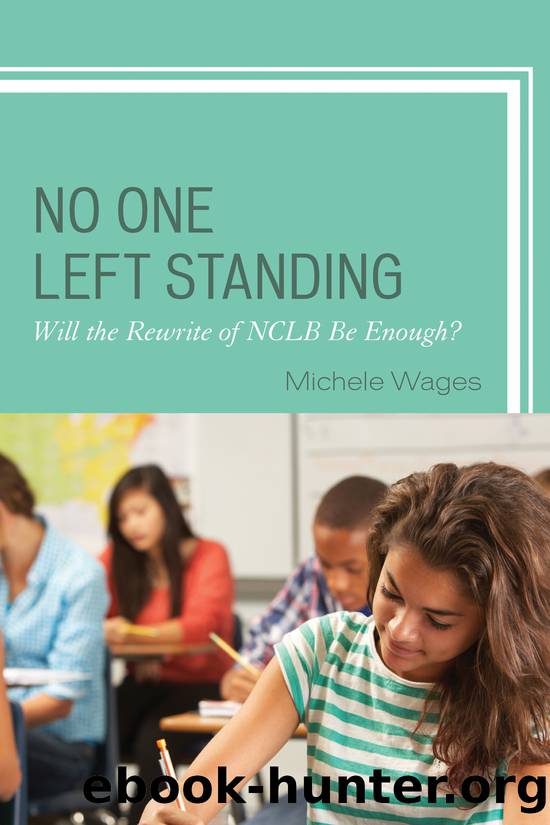No One Left Standing by Wages Michele;

Author:Wages, Michele;
Language: eng
Format: epub
Publisher: Rowman & Littlefield Publishers, Incorporated
Chapter 7
How Is the Increase in Cultural Diversity Affecting Standardized Testing?
A schoolâs culture has more influence on life and learning in the schoolhouse than the president of the country, the state department of education, the superintendent, the school board, or even the principal, teachers, and parents can ever have.
âRoland Barthes
Just because some students score higher than others on a test does not make it biased. A biased test is when the scores of one group are significantly different and have a higher future performance prediction than another group. Most test biases are considered cultural biases. âCultural bias is the extent to which a test offends or penalizes some students based on their ethnicity, gender or socioeconomic statusâ (Hurst, 2015).
TYPES OF BIAS
Basically, the fact that differential performance between and among groups exists is where bias concerns originate. The question of why one group performs differently than another on a consistent basis leaves concerns as to the individual characteristics of examinees, the testing environment, and/or characteristics of the test or test items needing to be answered.
Hurst (2015) goes on to explain the different types of test biases that affect the accuracy and usability of the test results.
Bias in Construct Validity. Bias in construct validity is present when a test is shown to measure different hypothetical constructs or traits for one group versus another; this type of bias also exists when the test measures the same trait for groups but with differing degrees of accuracy. The primary question is: Does the item or test measure what it is intended to measure? One example of this has to do with a childâs first language. Testing a second language learner whose first language is not English can be problematic if the child is not proficient. This can cause an achievement test to become a language test, in which the child may actually know the correct answer to the question, but because of the language barrier, cannot understand what is being asked.
Bias in Content Validity. This bias is due to a studentâs lack of exposure or experience and therefore is at a disadvantage of how to correctly answer a question. For example, if a student is asked the question, âHow are basketball and football alike?â a student or group who has never played, watched, or had discussions about basketball is at a disadvantage. Reynolds (1998) lists three examples of content bias:
The items ask for information that minority persons have not had the same experience or opportunity to learn as others.
The scoring of the item is inappropriate. In other words, a member of a minority group may be penalized for giving an answer that does not match the answer key, but would be correct in his or her culture.
The wording or registry used in the questions are unfamiliar, whereas the student may know the correct answer but is not able to understand what is being asked or has no experience with the test format.
Download
This site does not store any files on its server. We only index and link to content provided by other sites. Please contact the content providers to delete copyright contents if any and email us, we'll remove relevant links or contents immediately.
The Art of Coaching Workbook by Elena Aguilar(50168)
Trainspotting by Irvine Welsh(21078)
Twilight of the Idols With the Antichrist and Ecce Homo by Friedrich Nietzsche(18324)
Fangirl by Rainbow Rowell(8819)
Periodization Training for Sports by Tudor Bompa(7947)
Change Your Questions, Change Your Life by Marilee Adams(7405)
This Is How You Lose Her by Junot Diaz(6476)
Asking the Right Questions: A Guide to Critical Thinking by M. Neil Browne & Stuart M. Keeley(5388)
Grit by Angela Duckworth(5322)
Red Sparrow by Jason Matthews(5226)
Paper Towns by Green John(4826)
Room 212 by Kate Stewart(4767)
Ken Follett - World without end by Ken Follett(4467)
The Sports Rules Book by Human Kinetics(4099)
Housekeeping by Marilynne Robinson(4084)
Double Down (Diary of a Wimpy Kid Book 11) by Jeff Kinney(3959)
Papillon (English) by Henri Charrière(3942)
The Motorcycle Diaries by Ernesto Che Guevara(3804)
Exercise Technique Manual for Resistance Training by National Strength & Conditioning Association(3798)
